Macrame
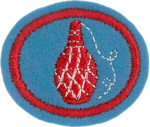
- Skill Level: 1
- Original Honor: 1975
- Originating Institution: General Conference
Requirements:
- Give a brief history of the art of decorative knotting.
- What is a good macrame cord?
- Know three kinds of cords that are good and why they are good.
- Know the basic knots used in macrame. Know two variations of each of these knots.
- How is the overhand knot useful in macrame?
- How much cord is needed to reach the desired length of the finished product?
- Make a sampler wall hanging using the essential knots and using at least two variations, such as the horizontal half-hitch, vertical half-hitch, or the half knot.
- Make two other items of your choice using the square knot, the double half-hitch, and two variations of either or both items.
Maori Lore
 Skill Level: 2
Skill Level: 2- Original Honor: UNK
- Originating Institution: South Pacific Division
Requirements:
1. Define the following commonly used terms:
- a. Maree
- b. Powhiri
- c. Karakia
- d. Mate
- e. Waiata
- f. Korero
- g. Haka
- h. Kuia
- i. Tane
- j. Wero
- k. Mana
- l. Manuhiri
- m. Hongi
- n. Hui
- o. Poroporoaki
- p. Whanau
- q. Tangi
- r. Aroha
- s. Whakairo
- t. Koro
- u. Kaumatua
- v. Wahine
- w. Mihi
- x. Whaikorero
- y. Tangata whenua
- z. Taonga
- 2. a. Draw or trace a map of the world and show with arrows the directions of
- Polynesian settlement.
- b. Where do Maoris consider themselves to have come to New Zealand from?
- c. Explain what the Great Migration Myth is. Who was the originator of the myth? What were the canoes that arrived in this migration and where did they come from?
- d. Draw or trace a map of New Zealand showing all the major tribal areas, and make in the canoe for each. (SIC)
- e. Why was Rangitoto named ìRangitotoî?
3. Visit a marae with a group that has been called to a hui. Write a report on the events that take place from the time you arrive at the marae to the time you leave. State the name of the marae, its locality and the tribe to which it is affiliated.
4. Briefly relate the customs observed at each of the following events:
- a. Mate
- b. Meal times
- c. Speeches
- d. Sleeping
5. Religious Culture
- a. What are the two Maori religions currently in use today, and what are some of their characteristics?
- b. Briefly describe the Maori story of creation.
- c. Briefly outline the story of Seventh-day Adventism among the Maori people.
- d. What is the Maori attitude to religion in general?
6. Make a sample tukutuku panel (approx 30cm x 30cm) OR a tipare OR a small flax mat/basket.
7. Know how to correctly:
- a. Greet people in Maori
- b. Hongi
8. a. What are five different pastimes enjoyed by Maori children in former times?
b. Learn how to do three string figures and walk on stilts.
9. Visit an old pa site in your locality and make a brief written report on what you could see.
Metal Craft

- Skill Level: 2
- Original Honor: 1937
- Originating Institution: General Conference
Requirements:
- Name the various metals that can be used in metal craft.
- Complete one project using metal foil tooling. Complete the project by antiquing and framing.
- Complete one project using metal punch.
- Complete one project using drilling, riveting, and bending of metal such as a simple candle holder.
- Demonstrate properly the use of the following:
- a. Tin Snips
- b. Pop rivet
- c. Electric drill
- d. Metal file
Model Boats

- Skill Level: 2
- Original Honor: 1991
- Originating Institution: General Conference
Requirements:
1. Do two of the following:
- a. Purchase and build one kit for a sailboat 10 to 15 inches (25.4 to 38.1 cm) long and about four to five inches wide and operate boat on the water for at least two minutes.
- b. Build a model boat with an electric motor from your own plans or from a kit, size 10 to 18 inches, (25.4 to 45.7 cm) and operate the boat for three to five minutes.
- c. Build a model boat 18 to 30 inches (45.7 to 76.2 cm) long from your own plans or from a kit. Install a small bore internal combustion engine .029 or .049 and operate for at least two successful runs of three to five minutes each. Record in writing the operating characteristics of the model and state what you did to improve its performance.
2. Identify and define these words:
- a. Displacement
- b. Center of gravity
- c. Propeller pitch
- d. Thrust and lift
- e. Mono hull
- f. Hydro
- g. Bow
- h. Keel
- i. Transom
- j. Cavitation
- k. Heeling
- l. Planing
- m. Drag
Model Cars
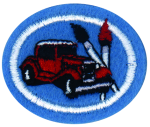
- Skill Level: 1
- Original Honor: 1928
- Originating Institution: General Conference
Requirements:
1. Build at least one plastic model car from the parts supplied in a kit. Car must be stock in every respect.
2. Build a second car using extra accessories included in the kit or create alterations using putty and/or parts from other kits. (Decals donít count). Include paint job.
3. Write or give orally a report on the history of automobiles. Be sure to include interesting steps in the development process such as notes on engine sizes, automatic transmissions, power steering, computerized controls, etc. Model Cars
- Skill Level: 1
- Original Honor: 1928
- Originating Institution: General Conference
Requirements:
- 1. Build at least one plastic model car from the parts supplied in a kit. Car must be stock in every respect.
- 2. Build a second car using extra accessories included in the kit or create alterations using putty and/or parts from other kits. (Decals donít count). Include paint job.
- 3. Write or give orally a report on the history of automobiles. Be sure to include interesting steps in the development process such as notes on engine sizes, automatic transmissions, power steering, computerized controls, etc.
Model Hot Air Balloons
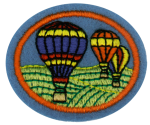
- Skill Level: 1
- Original Honor: 2008
- Originating Institution: North American Division
Requirements:
1. State the role each of the following played in the development of flying balloons.
- a. Joseph Michel Montgolfier and Jacques-Etienne Montgolfier.
- b. Jean Francois Pilatre de Rozier and Francois Laurent Marquis d’Arlandes.
- c. Jacques Alexandre Cesar Charles and Nicolas Louis Robert.
- d. Ben L. Abruzzo, Maxie L. Anderson, and Larry Newman
- e. Bertrand Piccard and Brian Jones
2. Cite the principle of Archimedes, and briefly describe how it applies to each of the following:
- a. A piece of cork floating in a bowl of water.
- b. A ship floating in the ocean
- c. A hot air balloon floating in the atmosphere
3. Using a textbook of Chemistry, or a reference book of scientific tables, draw up a simple table showing the composition of air by weight and by volume.
4. Draw up a simple table showing a comparison of the atomic number, atomic weight, and density of hydrogen, helium, nitrogen, and oxygen.
5. Name two gases that are used in flying gas filled balloons.
6. Explain how heat/temperature affect the density of air, and how this applies to flying hot air balloons.
7. Explain the role of each of the following in the structure and flying of a hot air balloon.
- a. Envelope
- b. Support structure
- c. Throat
- d. Fuel source
8. Name two materials that may be used for the envelope of a hot air balloon, and compare the advantages each cords because of its properties.
9. Describe how flying balloons have served a useful function in
- a. Military campaigns
- b. Scientific research
10. At what time of the day do most sport balloon flights take place? Why?
11. Describe how a pilot controls the vertical movement of
- a. A hot air balloon
- b. A gas filled balloon
12. Describe how a pilot controls the lateral or horizontal movement of a flying balloon.
13. Build to completion one model hot air balloon ( or two if working in pairs ).
14. Successfully launch, fly, and recover the model hot air balloon(s) which you have built.
Model Railroad

- Skill Level: 2
- Original Honor: 1967
- Originating Institution: General Conference
Requirements:
1. Give the history and development of model railroading.
2. Tell the difference in how the following prototype motive power units operate:
- a. Steam
- b. Diesel
- c. Electric
3. Know the name, scale, and track gauge for four model railroad gauges.
4. Know the shapes and names of at least eight track plan arrangements.
5. Know at least six points to check for the maintenance of a model railroading layout.
6. Identify and explain the use of:
- a. Five types of freight cars
- b. Three types of passenger cars
- c. Three types of steam engines according to their wheel arrangement
- d. Two types of grade crossing warning devices
- e. Two types of railroad signals
- f. Five types of railroad-related buildings or structures
7. Know the meaning of the following model railroad terms:
- a. Ballast
- b. Blind drivers
- c. Block
- d. Bolster
- e. Crossing
- f. Crossover
- g. Double header
- h. Draft gear
- i. Flange
- j. Frog
- k. Gap
- l. Gauge
- m. Grade
- n. Gravity yard
- o. Hot box
- p. Insulated rail joiner
- q. Journal
- r. Layout
- s. Mainline
- t. Prototype
- u. Rail joiner
- v. Reverse loop
- w. Siding
- x. Spur
- y. Switch
- z. Machine
- aa. Talgo truck
- bb. Truck
- cc. Turnout
- dd. Two-rail
- ee. Wye
- ff. Y switch
- gg. Yard
8. Construct a portion of a model railroad layout. In your construction, do the following:
- a. Assist in assembling the framework
- b. Install a section of ballast
- c. Install a section of track
- d. Install at least one turnout, including the wiring
- e. Assist in making scenery, such as trees, rocks, mountains, or grass
- f. Make one model railroading building or structure
- g. Assist in the wiring to supply electrical power to the tracks
9. Successfully operate a model railroad train on the layout you have assisted in building.
Model Rocketry
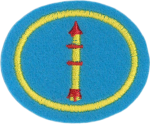
- Skill Level: 1
- Original Honor: 1970
- Originating Institution: General Conference
Requirements:
(Instructor Required)
1. Know and explain the Model Rocketry Safety Code.
2. Know and explain the importance of the basic model rocket components.
3. Draw the following:
- a. The steps in the flight of a model rocket
- b. A cut-a-way view of a model rocket engine, labeling each part
- c. A schematic plan for a simple launch system using proper electrical symbols
- 4. Define the following:
- a. Wadding
- b. Boost gliders
- c. Stall
- d. Payload
- e. Apogee
- f. Center of gravity
- g. Center of pressure
- h. Impulse
- i. Velocity
- j. Ejection
5. Name and describe at least four different recovery systems.
6. From a kit, build, finish, and paint a single-stage rocket that has a minimum length of six inches with a recovery system, such as a parachute or streamer. Successfully launch and recover the rocket with the recovery system deploying properly.
Model Rocketry, Advanced

- Skill Level: 2
- Original Honor: 1970
- Originating Institution: General Conference
Requirements:
(Instructor Required)
- Have the Model Rocketry Honor.
- From a kit, build, successfully launch, and recover a boost glider.
- Design, build (not from a kit), finish, and paint a single-stage rocket. Check for stability, and successfully launch and recover this rocket.
- Do one of the following:
- a. From a kit build, finish, and paint a two-stage rocket. Successfully launch and recover this rocket.
- b. From a kit, build, finish, and paint a three-engine clustered single-stage rocket. Successfully launch and recover this rocket.
5. Design an electrical launch system. When this has been approved by your instructor, build this system and use it to launch rockets at least five times.
6. Describe and demonstrate single station altitude tracking. With the aid of a helper, track the same rocket three times using three different sizes of engines and compare altitudes with an altitude finder.
7. Compare the velocity and altitude of two different weights of rockets using the same size engine.
Music
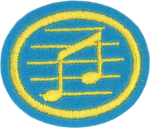
- Skill Level: 1
- Original Honor: 1929
- Originating Institution: General Conference
Requirements:
(Instructor Required)
- Play or sing a scale and know its composition.
- Write a scale in both treble and bass clef.
- Know a half-tone, a whole tone, a third, a fifth, and an octave.
- Distinguish a march from a waltz and give the time of each.
- What is a quarter note? A half note? A whole note? Draw the symbols of each.
- Name five great composers and one composition of each, including an oratorio, a piano composition, and a song.
- Play with or without music or sing from memory 15 hymns (one verse or stanza each) and/or other sacred songs or choruses and list the composer of each.
- Play or sing from memory one piece of good music other than those used in #7.
- Do one of the following:
- a. For instrumentalists, be able to sight-read and play a moderately difficult piece of music. Explain all signs and terms in it.
- b. For singers, show with baton or arm how to lead a group in singing compositions written in 3/4 and 4/4 time.
10. Define orchestra and name at least five instruments in an orchestra.
11. Do a biographical sketch on a famous hymn writer and orally present it to a group.
Music, Advanced
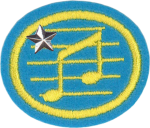
- Skill Level: 2
- Original Honor: 1UNK
- Originating Institution: South Pacific Division
Requirements:
(Instructor Required)
- Complete the Music Honor.
- Pass in Grade 7 Practical AMEB, or Trinity College, or Royal Schools of Music, or Suzuki Graduation Level 5.
- Be able to play or sing any hymn chosen at random from the Church Hymnal or Sabbath School chorus books.
Needlecraft

- Skill Level: 2
- Original Honor: 1928
- Originating Institution: General Conference
Requirements:
1. Do two of the following:
- a. Embroider one of the following: dresser scarf, pair of pillowcases, luncheon cloth, or other equivalent article.
- b. Make a pillow cover or wall hanging, a set of four sachet pillows, or three tree ornaments out of any of the following methods:
(1) Punch embroidery
(2) Candlewicking
(3) Crewel
- c. Make a pillow cover, wall hanging, cover for chair, footstool, or piano bench in needlepoint or counted cross stitch.
- d. Make an article using any of the following methods:
(1) Applique
(2) Fagoting
(3) Smocking
(4) Shirring
(5) Swedish weaving on linen or huck toweling
2. Show articles you have made, using ten of the following stitches:
- a. Back
- b. Blanket
- c. Braid
- d. Buttonhole
- e. Roman
- f. Chain
- g. Cross
- h. Feather
- i. Fishbone Stem
- j. French knot
- k. Heavy chain
- l. Herringbone
- m. Lazy daisy
- n. Long and short
- o. Outline
- p. Running
- q. Satin
- r. Split
- s. Star filling
- t. Stem
- u. Whipping
3. Show the correct way of gathering lace and whipping it to hemmed edge.
4. Describe a satisfactory method of keeping your fancy-work equipment in good equipment.
Native American Lore (formerly Indian Lore)
- Skill Level: 1
- Original Honor: 1944
- Originating Institution: General Conference
Requirements:
- Name five uses made of natural materials by the Northwest Indians.
- Name five uses made of the yucca plant by the Southwest Indians.
- Name five uses made of the birch tree by the Eastern Woodland Indians.
- Know 15 plant foods introduced to us by the Indians. Include four plant names used today.
- Describe Indian stalking and tracking.
- Name five rocks and/or minerals and uses made of them by the Indians.
- Explain one way in which arrowheads were made by the Indians.
- Define pictograph. What are Indian petroglyphs and where can you find them?
- Describe the use of seashells by the Indians.
- Name at least ten materials used in making Indian arts and crafts.
- Make a craft item, using any of the materials named in requirement nine (9)
Native American Lore, Advanced

- Skill Level: 2
- Original Honor: 1976
- Originating Institution: General Conference
Requirements:
- Have the Indian Lore Honor.
- Know and have a list of at least 40 foods introduced to us by the Indians of North and South America.
- Participate in a meal using as many Indian foods and cooking methods as possible.
- Name five drugs or medicine plants used by the Indians.
- Discuss the Indians of your area with regard to:
- a. Tribes located there
- b. Homes and clothing
- c. Native crafts performed, such as basketry, pottery, mats, etc.
- d. Religious practices
- e. Form of Government
6. Name ten articles used by the Indians in their religious ceremonies.
7. Explain two methods of mounting and displaying arrowheads.
8. Explain one method of restoring and mending damaged arrowheads, ollas, blankets, and baskets.
9. Name and locate at least ten different tribes of the present day and tell for what each is noted.
10. Experiment with plant dyes as used by the Indians and try to obtain at least two shades of color.
11. Do one of the following:
- a. Visit an Indian museum
- b. Visit Indian ruins or mounds
- c. Make a personal visit with an Indian
- d. Visit an Indian village or reservation
Origami

- Skill Level: 1
- Original Honor: 1997
- Originating Institution: General Conference
Requirements:
- What is Origami? Where did it come from? How was it used and developed?
- Identify the symbols for the following terms:
- a. Valley fold
- b. Mountain fold
- c. Cut
- d. Existing crease
- e. Hold here
- f. Watch this spot
- g. In front
- h. Behind
- i. Tuck in, open out, or apply force
- j. Fold over and over
- k. Turn model over
3. Demonstrate folding the following folds:
- a. Reverse fold
- b. Squash fold
- c. Petal fold
- d. Book fold
- e. Preliminary fold
- f. Blintz fold
4. Demonstrate folding the following bases:
- a. Bird base
- b. Waterbomb base
- c. Frog base
5. Do three of the following models:
- a. House
- b. Lotus blossom
- c. Cicada
- d. Housefly
- e. Butterfly
6. Choose three of the following models to fold or select similar models from Origami books:
- a. Jumping Frog
- b. Carrier Pigeon
- c. Sailboat
- d. Hen
- e. Leaf
- f. Walking dog
- g. Duck
7. Fold one model of your choice from memory from requirement 5 or 6.
8. Illustrate a Bible story using several Origami models.
Painting
Skill Level: 2
Original Honor: 2013 (Drawing & Painting originated 1929)
AdventSource Honors Handbook PDF
AdventSource Catalog: Patch Order (must have approved order login) (link from AdventSource)
Wikibooks.org Article/Answer Key
Originating Institution: North American Division
Requirements:
The Drawing honor was created in 2013 when the NAD Honor Taskforce voted to expand and replace the Drawing and Painting honor with four new honors: Drawing, Drawing – Advanced, Painting, and Painting – Advanced. The new Painting honors adopted the insignia for the old Drawing and Paining honor, and the new Drawing honor received a new insignia.
1.Have the Basic Drawing Honor
2.Create a Color wheel using crayon or color pencil. Include and understand:
a.Primary Colors
b.Secondary Colors
c.Tertiary Colors
d.Neutral Colors
e.Warm/Cool Colors
f.Tints
g.Shades
3.Create a Value Scale of a warm and a cool color, using color pencil.
4.Name seven (7) color media.
5. What is the difference between water based and oil-based paints? Name 2 of each type.
6.What paint media was made with egg yolk?
7.Define the following and tell how they are used:
a.Gesso
b.Masking fluid (Miskit)
c.Mineral Spirits/Turpentine
d.Palette
e.Easel
8. Describe what the following brushes are used for:
a.Rounds
b.Flats
c.Liner Brush
d.Fan Brush
e.Mop Brush
9.What is the best way to care for paint brushes?
10.Describe and be able to explain the difference between:
a. Realistic Art
b. Abstract Art
11.Know the difference and show examples or the following Subject Matter:
a. Portrait
b.Landscape
c.Still Life
d.Abstract
12.Draw and paint, in your choice of color media, a still life or floral subject.
13.Paint a landscape showing linear perspective.
14.Paint a portrait of a friend and/or favorite pet from a photo.
15.Memorize Psalm 19:1. Discuss how this text inspires your Artwork.
Painting, Advanced
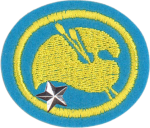
Skill Level: 3
Original Honor: 2013
AdventSource Honors Handbook PDF
AdventSource Catalog: Advanced Star Order (must have approved order login) (link from AdventSource)
Wikibooks.org Article/Answer Key
Originating Institution: North American Division
Requirements:
1.Earn the Basic Painting Honor
2.Describe these styles of painting and show examples of 3 artist’s work in each style:
a.Impressionism
b.Pointilism
c.Fauvism
d.Realism
3.Know how to stretch a canvas for painting.
4.Paint 5 paintings. Use at least 3 different media and at least 3 different subjects; one of which is multi-media.
5.Give 2 examples of contemporary painters and give 3 reasons why you appreciate their work.
6.Memorize: Gen 9:13. Discuss why God has filled the earth with color and variety; and how He has touched or changed your thoughts about life and art personally
Paper Mache
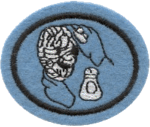
Skill Level: 1
Original Honor: UNK
AdventSource Honors Handbook PDF
AdventSource Catalog: Patch Order (must have approved order login) (link from AdventSource)
Wikibooks.org Article/Answer Key
Originating Institution: General Conference
Requirements:
1. Name at least three kinds of bases upon which paper models may be shaped.
2. There are two main types of paper machÈ:
a. Know how to prepare successful pulp
b. Know how to prepare the glue
3. Be familiar with all ingredients and know why they are used.
4. Make, paint and varnish at least two articles from pulp.
5. Make, paint and varnish at least two articles from paste and paper strips.
6. Submit articles to examiner and have workmanship approved.
Paper Quilling

Category: Arts, Crafts, and Hobbies
Skill Level: 1
Original Honor: 2006
Adventsource Honors Handbook PDF
Adventsource Catalog: #006067 Patch Order (must have approved order login) (link from adventsource)
Wikibooks.org Article/Answer Key
Originating Institution: North American Division
Requirements:
1. What was paper quilling called when the craft first began?
2. Know the history of quilling.
3. Know the tools used in quilling
4. Know and be able to correctly make each of the following rolls:
a. Tight Circle
b. Loose Circle
c. Teardrop
d. Shaped Teardrop
e. Marquise
f. Shaped Marquise
g. Crescent n Holly Leaf
h. Square
i. Rectangle
j. Triangle
k. Bunny Ear
l. Half Circle
m. Rolled Heart (Arrow)
5. Know and be able to correctly make each of the following scrolls:
a. Loose Scroll
b. Open Heart
c. V Scroll
d. S Scroll
e. C Scroll
6. Make a simple floral design by using at least three of the methods above.
7. Make a filled-in picture or ornament.
Paper Quilling, Advanced
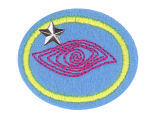
Category: Arts, Crafts, and Hobbies
Skill Level: 2
Original Honor: 2006
Adventsource Honors Handbook PDF
Adventsource Catalog: #007400 Advanced Star Order (must have approved order login) (link from adventsource)
Wikibooks.org Article/Answer Key
Originating Institution: North American Division
Requirements:
1. Know and be able to correctly make each of the following Eccentric shapes
a. Eccentric Loose Circle
b. Eccentric Teardrop
c. Eccentric Marquise
d. Eccentric Fan
e. Eccentric Crescent
f. Eccentric Bunny Ear
g. Eccentric Tulip
2. Know and complete three of the following shaping techniques.
a. Fringed Flower
b. Grape Roll
c. Spiral
d. Loop Method
e. Pegs
f. Weaving Paper
g. Twisted Loop
h. Huskings
i. Folded Roses
j. Curled Flowers
3. Make a picture or ornament using at least three of the Eccentric Shapes.
4. Make a three-dimensional object.
Photography

Skill Level: 2
Original Honor: 1928
AdventSource Honors Handbook PDF
AdventSource Catalog: Patch Order (must have approved order login) (link from AdventSource)
Wikibooks.org Article/Answer Key
Originating Institution: General Conference
Requirements:
1. Explain the principles of camera construction, what the camera lens does, the effect of light on light-sensitive film, and the action of developers.
2. What is meant by the “speed” of the film? What does ASA/ISO mean?
3. How are shutter speed, lens aperture, and film speed related?
4. Give the principal uses of photography.
5. Take print or slide pictures illustrating at least eight of the following techniques. Use comparison pictures for illustration:
a. Framing
b. Camera steadiness
c. Direction of lighting – front, backlighting, side
d. Panning – background blurred with subject in focus
e. Rule of thirds
f. Angle – eye level, high and low angle
g. Level horizon
h. Distance from subject – fill the frame
i. Use of leading lines
j. Quality of light – shade, sunlight, and time of day
k. Correct exposure – underexposed, overexposed, and correctly exposed
l. Use of flash – distance and reflective objects
6. Do one of the following:
a. Tell how black and white film is developed into negatives and print eight of your own pictures.
b. Tell how slides are made and develop one roll of film.
Pin Trading
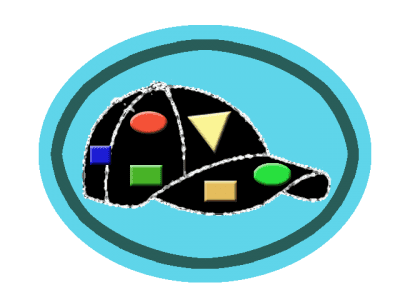
Skill Level: 1
Category: Arts, Crafts, and Hobbies
Original Honor: 2014
Adventsource Honors Handbook PDF
AdventSource Catalog: Patch Order (must have approved order login) (link from AdventSource)
Wikibooks.org Article/Answer Key
Originating Institution: North American Division
Requirements:
1. Explain the origins of pin trading, and how it got started in the Pathfinder Club.
2. Define the following terms:
a. Button
b. Clutch
c. Etiquette
d. Lanyard
e. Pin
f. Venue
3. Identify two of the most common types of pin backs, and demonstrate or describe how to safely attach and remove them.
4. Name at least five places where you can get pins for trading, including free or inexpensive pins. Collect at least three to five pins for trading from one or more of these sources.
5. Discuss at least five different methods of displaying your pins for trading. Choose a method you like and arrange your pins for trading.
6. Name five venues or events where pin trading is a popular activity.
7. Discuss the three F’s of pin trading etiquette:
a. Fun
b. Fair
c. Friendly
8. Discuss Matthew 6:19‐21 in light of trading and collecting pins. Include in your discussion:
a. How can one trade and collect pins without giving up our focus on heaven?
b. How can pin trading help us be more like Jesus?
c. What behaviors and attitudes should we avoid while pin trading?
9. Trade pins with at least five people you don’t know at a venue or event where pin trading takes place, using the “Fun, Fair, Friendly” principles of etiquette. Share with someone else or in a group any interesting stories or people you met while trading pins
Pin Trading, Advanced
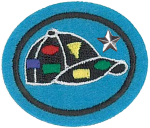
Skill Level: 2
Category: Arts, Crafts, and Hobbies
Original Honor: 2014
Adventsource Honors Handbook PDF
Adventsource Catalog: Advanced Star (must have approved order login) (link from adventsource)
Wiki.Pathfindersonline.org Answer Key
Originating Institution: North American Division
Requirements:
1. Have the Pin Trading Honor.
2. Identify the factors that affect the following about pins:
a. Cost
b. Value
3. Describe the following types of pins:
a. Cloisonné
b. Die Cast
c. Die Struck
d. Hard Enamel
e. Offset Printed
f. Photo Etched
g. Silk Screened
h. Soft Enamel
4. What is an epoxy dome, and what are its advantages and disadvantages?
5. Identify the following types of pin accessories or embellishments:
a. Blinker
b. Bobble Head
c. Dangler
d. Glitter
e. Rhinestones
f. Slider
g. Spinner
h. Twirler
6. Identify the following types of pin backs, and demonstrate or describe how to safely attach and remove them:
a. Locking Clutch
b. Locking Safety Pin Clasp
c. Magnetic Back
d. Safety Pin Clasp
7. Discuss how the “Golden Rule” applies to pin trading etiquette.
8. Complete two of the following activities related to pin trading:
a. Collect a complete “set” of pins by trading at one of the pin trading venues.
b. Collect at least two free pins at exhibit booths at a camporee, convention, trade show, or other event.
c. Make a handmade pin book for displaying your collection of pins.
d. Make two or more handmade pins for trading.
e. Set up a display of your pin collection at church for Pathfinder Sabbath, at a Pathfinder Fair, or at another event like a state or county fair.
f. Submit a design to your club or conference for a camporee trading pin.
g. Write two or more letters to your city, state, or province, or to companies that sponsor sporting events or the Olympics, and ask if they have pins. If they send you a free pin(s), be sure to follow up with a thank‐you letter.
9. Do one of the following to help a new pin trader, then discuss your experience with someone else or in a group:
a. Be an advocate for a new pin trader and help in the trade using the “Fun, Fair,Friendly” principles of etiquette.
b. Give away one of your pins to a new pin trader in order to help him or her get started in pin trading.
10. Trade pins with at least fifteen people you don’t know at a venue or event where pin trading takes place, using the “Fun, Fair, Friendly” principles of etiquette. Keep a diary of the people you trade pins with and any interesting things that happen during your pin trading experiences.
Pinewood Derby
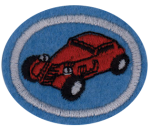
Category: Arts, Crafts, and Hobbies
Skill Level: 1
Original Honor: 1999
AdventSource Honors Handbook PDF
AdventSource Catalog: #006103 Patch Order (must have approved order login) (link from AdventSource)
Wikibooks.org Article/Answer Key
Originating Institution: North American Division
Requirements:
1. Name the four basic components of a Pinewood Derby car.
2. Cars must meet the basic following requirements:
a. Must be made during the current calendar year or Pathfinder club year.
b. Width of car shall not exceed 2 3/4” or 70 mm
c. Length of car shall not exceed 7” or 178 mm
d. Weight of car shall not exceed 5 oz. (142 grams)
e. Width between wheels shall be 1 3/4” or 44 mm
f. Height from bottom of car to bottom of tires shall be 3/8” minimim or 10 mm
g. Use only axles, wheels, and wood provided in the kit you purchase.
h. Wheel bearings, washers, and bushings are prohibited.
3. Know how to safely use the following while building your project:
a. Saw
b. Wood rasp
c. Course sandpaper
d. Fine sandpaper
e. Wood plane
f. Hammer
g. Shaping stick
4. Know the basic steps in designing a car:
a. Design
b. Transfer of design
c. Building the car
d. Axles and wheels
e. Adding weight
f. Lubrication
5. Design and build to completion a Pinewood Derby car from a basic kit using the instructions in the kit or if no instructions, follow the directions in #2.
6. Participate in a sponsored Pinewood Derby event using the car you built in number five (5).
7. Define and practice good sportsmanship as it relates to your Christian walk.
Note: If you are planning to participate in a conference Pinewood Derby event be sure you use the correct specifications from your conference because some use different specifications than listed above.
Where to Order:
S & W Crafts Manufacturing
PO box 5501
Pasadena, CA 91117
Pinewood Derby, Advanced
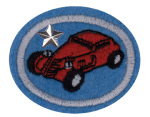
Category: Arts, Crafts, and Hobbies
Skill Level: 2
Original Honor: 1999
Adventsource Honors Handbook PDF
Adventsource Catalog: #007400 Advanced Star Order (must have approved order login) (link from adventsource)
Wikibooks.org Article/Answer Key
Originating Institution: North American Division
Requirements:
1. Have the Pinewood Derby Honor.
2. Know the Pinewood Derby race regulations for your district, area, or conference. NOTE: Many conferences have special Pinewood Derby events and the rules may vary as to length, weight and wheels.
3. Be aware of the following:
a. Cars shall not ride on any kind or type of springs.
b. No loose materials of any kind are allowed in or on the car.
c. Official number must be clearly marked and visible.
4. Review tool safety.
5. Know the various ways to prepare and finish your project:
a. Sanding wood
b. Filling holes
c. Sealing new wood
d. Coloring wood
e. Gloss finishes
f. Enamel finishes
g. Stain finishes
h. Wax finishes
i. Acrylic finishes
j. Water colors
k. Leather look on wood
l. Decoupage
m. Forged foil
6. Know the principle meaning of friction and how it can effect the performance of your car.
7. Know the three best ways to reduce friction on your car.
a. Axle lubrication
b. Aerodynamic design
c. Smooth finish
d. Proper wheel/axle clearance
e. Reduce wheel shaking
8. Know the three theories of weight distribution and how it could affect the perfor- mance of your car.
9. Design and build to completion the following (not previously built):
a. Basic car kit with complete exterior finish
b. Deluxe/fancy car kit with complete exterior finish and decals
c. Be creative by building one of the following: tank, submarine, airplane, piano, ice cream sandwich, fire engine, vege-link, school bus, baby carriage, etc.
10. Use details on your project such as steering wheel, driver, decals, etc. as long as these details do not exceed the maximum length, width, and weight specification.
11. Participate in a club, district, or conference sponsored Pinewood Derby event with a current car.
12. Define and practice good sportsmanship as it relates to your Christian walk.
Plaster Craft
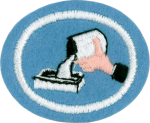
Skill Level: 1
Original Honor: 1967
AdventSource Honors Handbook PDF
AdventSource Catalog: Patch Order (must have approved order login) (link from AdventSource)
Wikibooks.org Article/Answer Key
Originating Institution: General Conference
Requirements:
1. What is the principal ingredient of plaster of Paris?
2. Give the steps in pouring a plaster item and preparing it for painting.
3. Know how to remove air bubbles from a poured item.
4. Know how the setup time can be increased or decreased for plaster.
5. What precautions should be taken when cleaning the mixing and pouring equipment?
6. When is a sealant applied to a plaster item and why?
7. What type of paint is best to use on plaster craft items?
8. Paint three items that will include the following designs and techniques or equivalent:
a. Floral to show shading
b. Fruit to show highlighting
c. Animal to show fine line or detail
d. Religious motto to show letter highlighting
9. Mold and paint two additional items of different designs.
Plastic Canvas
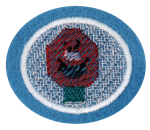
Category: Arts, Crafts, and Hobbies
Skill Level: 1
Original Honor: 2007
Adventsource Honors Handbook PDF
Adventsource Catalog: #005734 Patch Order (must have approved order login) (link from adventsource)
Wikibooks.org Article/Answer Key
Originating Institution: North American Division
Requirements:
1. What is plastic canvas?
2. Name four (4) types of plastic canvas and give a brief description of each.
3. Which type of yarn is best for use on plastic canvas?
4. Describe the following types of yarn and say on which type of canvas they work best.
a. Worsted Weight Yarn
b. Sport Weight Yarn
c. Tapestry Yarn
d. Persian Wool
e. Pearl Cotton
f. Embroidery Floss
5. What type of needle is used on plastic canvas? Which size needle is used on each type of plastic canvas?
6. Which instruments are used for cutting plastic canvas? How do you cut plastic canvas?
7. Name at least ten (10) stitches and make a one-inch sample of each.
8. Make two of the following items using three different stitches.
a. Coaster
b. Bookmark
c. Picture Frame
d. Refrigerator Magnet
e. Christmas Ornament
f. Door Hanger
9. Make one of the following using four different stitches.
a. Tissue Box Cover
b. Tote Bag
c. Disk Holder
d. Trinket/Coaster Box
Plastic Canvas, Advanced

Category: Arts, Crafts, and Hobbies
Skill Level: 2
Original Honor: 1999
Adventsource Honors Handbook PDF
Adventsource Catalog: #007400 Advanced Star Order (must have approved order login) (link from adventsource)
Wikibooks.org Article/Answer Key
Originating Institution: North American Division
Requirements:
1. Earn the Plastic Canvas honor.
2. Name six (6) stitches (not previously used in Plastic Canvas, Basic) and make a two-inch sample of each.
3. Use four (4) of these stitches to design your own round Plastic Canvas basket. The basket should have a handle and a cover. Be as creative as possible.
4. Make a six-piece coaster set with a matching coaster box for your kitchen.
5. Make an item of your choice. Use your imagination, be creative and moreover, have fun!
Plastics
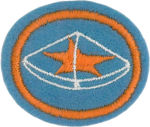
Skill Level: 2
Original Honor: 1961
AdventSource Honors Handbook PDF
AdventSource Catalog: Patch Order (must have approved order login) (link from AdventSource)
Wikibooks.org Article/Answer Key
Originating Institution: General Conference
Requirements:
1. Make a list of the materials and equipment used in making small castings in plastic molds.
2. Know how to clean and properly take care of plastic molds.
3. What safety precautions should be used when working with plastics?
4. Tell how to mix resin for casting and colored layers.
5. Why are the following used?
a. Catalyst
b. Surface hardener
c. Pigments
6. What is meant by polymerization?
7. Prepare and embed two nature items suitable for embedding. Nature items may be embedded in one or more castings.
8. Make three castings with at least one item embedded in each casting
Postcard
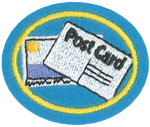
Skill Level: 1
Category: Arts, Crafts, and Hobbies
Original Honor: 2013
Adventsource Honors Handbook PDF
Adventsource Catalog: Patch Order (must have approved order login) (link from adventsource)
Wikibooks.org Article/Answer Key
Originating Institution: North American Division
Requirements:
1. Relate briefly the story of the beginning of the postcards in your country.
2. How was your country’s postal system affected by the coming of postcards?
3. What are the mailing rates for postcards and letters in your country?
4. What is the term used in your country for postcards collecting?
5. Give a brief description of each of the following eras of postcards:
a. Pre-postcard era
b. Pioneer era
c. Private mailing card era
d. Undivided back era
e. Divided back era
f. Early modern era (White Border)
g. Linen card era
h. Photo chrome era
6. Briefly describe each type of postcards:
a. View cards
b. Greeting cards
c. Historical cards
d. Art cards
e. Photographic cards
7. Show and label a picture of a postcard from each of the above eras.
8. Have some knowledge of preserving postcards.
9. Make a collection of at least 50 postcards. (No two postcards alike.) Your collection MUST include the following:
a. Begin your arrangement with a postcard of a religious nature
b. Postcards from at least 10 states/provinces/countries
c. Postcards from at least 2 other countries that are not your own
10. Arrange the collection of postcards in a suitable display and display at a pathfinder’s event.
11. How were greetings sent in Biblical times? 2 Cor 13:13, Phil 4:21 or 2 John 13.
Postcards, Advanced

Skill Level: 3
Original Honor: 2013
Adventsource Honors Handbook PDF
Adventsource Catalog: Advanced Star (must have approved order login) (link from adventsource)
Wiki Answer Key
Originating Institution: North American Division
Requirements:
1. Have the basic Postcard Honor.
2. How is the history of your city or state/province/region told in postcards? Collect postcards (or pictures of postcards) that illustrate events or distinctive scenery found in your area.
3. Explain what you have done to preserve your postcards. (Postcards from the basic honor)
4. What is the latest development in postcards?
5. What are the present regulations for sending custom made postcards through your local post office and getting the postcard rate?
6. Make a collection of at least 150 postcards. (No two postcards alike.) Your collection should include the following:
a. At least two postcards depicting significant historical or cultural heritage in your area/region.
b. Postcards from at least different 20 states/providences/countries.
c. At least 25 cards on the same theme (mountains, beaches, waterfalls, travel, religious, seasons, sports, animals, hobbies, art, et Al.)
7. Do two of the following:
a. Create your own postcards. Mail five of your personally created postcards in order to encourage someone.
b. Copy a map of U.S. and/or world map showing where your postcards are from and display at an event. Display your postcards of your choice topic. (You do not need to display the entire 150 postcards)
c. Create a game using postcards as game pieces
d. Create a digital album or media presentation that illustrates the history or scenery of the cards in your collection (minimum 30) in more detail
Pottery
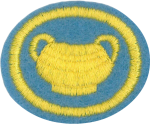
Skill Level: 2
Original Honor: 1938
AdventSource Honors Handbook PDF
AdventSource Catalog: Patch Order (must have approved order login) (link from AdventSource)
Wikibooks.org Article/Answer Key
Originating Institution: General Conference
Requirements:
1. Write or explain orally the different types and uses of pottery and the materials used in making it.
2. What is the purpose of a glaze? Describe the specific dangers to be avoided.
3. Design and draw two pottery forms, one of which must be decorated.
4. Do three of the following. Each project is to be decorated, such as painted, glazed, or indented:
a. Using the coil method, make a jar or vase.
b. Using the slab method, make a box.
c. Using the pinch pottery method, make one object.
d. Design and make four different tiles.
e Make a tray or dish.
f. Throw a simple vase on a potter’s wheel.
Scrapbooking
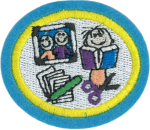
Category: Arts, Crafts, and Hobbies
Skill Level: 1
Original Honor: 2004
Adventsource Honors Handbook PDF
Adventsource Catalog: #NA Patch Order (must have approved order login) (link from adventsource)
Wikibooks.org Article/Answer Key
Originating Institution: North American Division
Requirements:
1. What is the purpose of Scrapbooking?
2. Why journal?
3. What is cropping and why is it done?
4. What are the four (4) main types of scrapbooks used?
5. What is the purpose of using acid-free products?
6. What are the four (4) different types of acid-free adhesive?
7. What ‘tool’ is used to sharpen scissors and punches when they get dull?
8. Name five (5) different types of acid-free paper used in Scrapbooking.
9. Make a scrapbook of at least 12 pages (8 1/2 x 11 or larger) on one of the following themes, and incorporating the use of colored paper, stickers, decorative scissors, matting and journaling.
•School Year
Sporting Events
Vacations
Holidays
Building Projects (mission trips, new home, etc.)
Wedding
Birthday Party
All About Me (birth to now)
Family Reunions
10. Memorize Joel 1:3 “Tell your children about it, Let your children tell their children, and their children another generation.”

 Skill Level: 2
Skill Level: 2
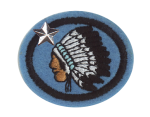
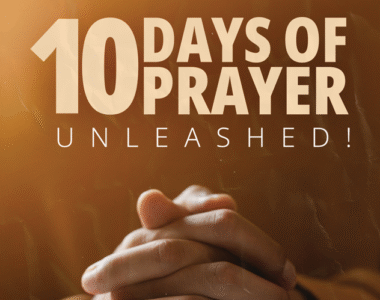


1 Comment